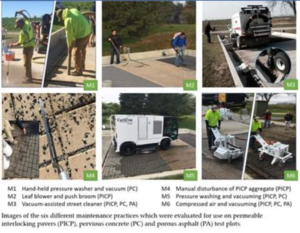
Assessing the performance of permeable pavement

Assessing the performance of permeable pavement includes a review of its condition and performance. A spring maintenance inspection is recommended and cleanup conducted as needed. The following are recommended annual maintenance inspection points for permeable pavements.
- The drawdown rate should be measured at the observation well for three (3) days following a storm event in excess of 1/2 inch in depth. If standing water is still observed in the well after two days, this is a clear sign the system is not performing as desired and subgrade soil clogging is a problem.
- Inspect the surface for evidence of sediment deposition, organic debris, water staining, or ponding that may indicate surface clogging. If any signs of clogging are noted, schedule a vacuum sweeper to remove deposited material. Then test sections using ASTM C1701 to ensure that the surface attains an infiltration rate of at least 10 inches per hour.
- Check inlets, pretreatment cells and any flow diversion structures for sediment buildup and structural damage. Remove the sediment.
- Inspect any contributing drainage area for any controllable sources of sediment or erosion
- Inspect the condition of the observation well and make sure it is capped.
- Inspect the structural integrity of the pavement surface, looking for signs of surface deterioration, such as slumping, cracking, spalling, or broken pavers. Replacement to rectify a damaged surface or one removed for access to utility repairs should be done per industry recommendations. After base compaction, small areas of pervious concrete and porous asphalt can be replaced with conventional (impervious) asphalt or concrete up to 10 percent of the total permeable pavement area. For PICP, paving units are removed for reinstatement later. The remaining undisturbed pavers at the perimeter of the opening are typically held in place with temporary wood or metal braces. Once the base is replaced and compacted, new bedding material and pavers are reinstated and compacted over the base.
An online manual for assessing BMP treatment performance was developed in 2010 by Andrew Erickson, Peter Weiss, and John Gulliver from the University of Minnesota and St. Anthony Falls Hydraulic Laboratory. The manual advises on a four-level process to assess the performance of a Best Management Practice.
- Level 1: Visual Inspection. This includes assessments for infiltration practices and for filtration practices. The website includes links to a downloadable checklist.
- Level 2: Capacity Testing. Level 2 testing can be applied to both infiltration and filtration practices.
- Level 3: Synthetic Runoff Testing for infiltration and filtration practices. Synthetic runoff test results can be used to develop an accurate characterization of pollutant retention or removal, but can be limited by the need for an available water volume and discharge.
- Level 4: Monitoring for infiltration or filtration practices
The adjacent table summarizes the four levels of assessment.
Levels of assessment for stormwater best management practices (stormwater control measures)
Link to this table
| Level | Title | Objectives | Relative | Typical elapsed time | Advantages | Disadvantages |
|---|---|---|---|---|---|---|
| 1 | Visual Inspection | Determine if stormwater BMP is malfunctioning | 1 | 1 day | Quick, inexpensive | Limited knowledge gained |
| 2 | Capacity testing | Determine infiltration or sedimentation capacity and rates | 10 | 1 week | Less expensive, no equipment left in field | Limited to infiltration and sedimentation capacity/rates, uncertainties can be substantial |
| 3 | Simulated runoff testing | Determine infiltration rates, capacity, and pollutant removal performance | 10-100 | 1 week to 1 month | Controlled experiments, more accurate with fewer tests required for statistical significance as compared to monitoring, no equipment left in field | Cannot be used without sufficient water supply, limited scope |
| 4 | Monitoring | Determine infiltration rates, capacity, and pollutant removal performance | 400 | 14 months | Most comprehensive. Assess stormwater BMP within watershed without modeling | Uncertainty in results due to lack of control and number of variables, equipment left in field |
Level 1 activities do not produce numerical performance data that could be used to obtain a stormwater management credit (stormwater credit). BMP owners and operators who are interested in using data obtained from Levels 2 and 3 should consult with the MPCA or other regulatory agency to determine if the results are appropriate for credit calculations. Level 4, monitoring, is the method most frequently used for assessment of the performance of a BMP.
Use these links to obtain detailed information on the following topics related to BMP performance monitoring:
- Developing an Assessment Program
- Water Budget Measurement
- Sampling Methods
- Analysis of Water and Soils
- Data Analysis for Monitoring
Additional information on designing a monitoring network and performing field monitoring are found at this link.
Related articles
- Overview for permeable pavement
- Types of permeable pavement
- Design criteria for permeable pavement
- Construction specifications for permeable pavement
- Assessing the performance of permeable pavement
- Operation and maintenance of permeable pavement
- Calculating credits for permeable pavement
- Case studies for permeable pavement
- Green Infrastructure benefits of permeable pavement
- Summary of permit requirements for infiltration
- Permeable pavement photo gallery
- Additional considerations for permeable pavement
- Links for permeable pavement
- References for permeable pavement
- Fact sheets for permeable pavement
- Requirements, recommendations and information for using permeable pavement BMPs in the MIDS calculator
Links to pages discussing assessment of other BMPs can be found at this page.
This page was last edited on 27 December 2022, at 15:33.

